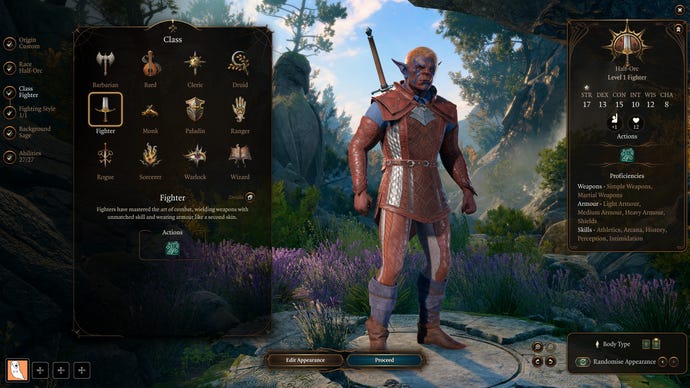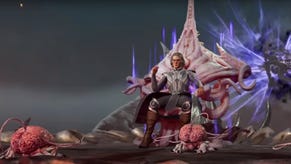Baldur's Gate 3 class tier list: Best classes for beginners, solo players, multiplayer, and more
Not sure which class to pick in Baldur's Gate 3? Here are our favourite beginner-friendly options, solo player picks, and more besides!
If you thought picking a character in a normal RPG was tough, then you’ve never tried to work out what the best class in Baldur's Gate 3 is.
It’s not just that there’s 12 classes to choose from, although that is a ridiculous amount. It’s that without experiencing the game for a protracted period of time, where you can get used to how your party performs and the situations you need to deal with in combat, genuinely how are you supposed to tell the difference between a Wizard, a Warlock and a Sorcerer?
Not only that, but not long after your adventure has started, you’re tasked with choosing a new subclass, further refining the specialist abilities your characters have access to.
Then there are the finer points of character creation in Baldur’s Gate 3 like your race and background.
Your background affects two key things: your skills and Inspiration. Skills are extra little things that your character is good at. The best skills are probably Persuasion, Sleight of Hand, Perception and Animal Handling because they pop up in dialogue checks often and have an effect on gameplay. But it’s not necessary to completely build your character around these though. Things like Arcana and History often give you really interesting lore even if it’s not always gameplay critical, and you will find a use for nearly every skill throughout your adventure.
Inspiration is a little different. Based on your background performing certain actions during your story will give you Inspiration points that you can use to re-roll dialogue checks that go against you. Again, this isn’t worth building specifically for, so don’t sweat it too much.
Additionally, these suggestions expect that you can choose whichever race you like. Unless you’re deliberately trying to make the most specialised build possible, I prefer to treat my character’s race as part of the role-play as most of their bonuses are adaptable to different situations. Baldur’s Gate 3 is based around Dungeons and Dragons for a reason - role-play whatever feels like fun!
Baldur's Gate 3 best class tier list
- SS Tier: Bard, Paladin
- S Tier: Cleric, Rogue, Warlock
- A Tier: Barbarian, Fighter, Sorcerer, Wizard
- B Tier: Druid, Monk, Ranger
It's worth stating up top that there are no bad classes in Baldur's Gate 3, and your selection should depend just as much on what you like the look of and think will suit your playstyle as on any advice you get from a tier list like this one.
A lot of different factors can go into making a class "the best". Is the best class the one that's easiest to build and play as? Has the most potential power in combat? Possesses one unique feature that's head and shoulders above every other trait in the game? There's a lot to consider, and you might well find that you personally vibe with a class that's not "the best" on paper. I for one am playing as a Druid on my main save and a Barbarian on my secondary save, neither of which are anywhere near the top of my own tier list! But this is what happens when you try to apply objectivity to something so subjective.
Nevertheless, if you want more details on why some classes might be better than others in certain situations, read on below. We've outlined some classes and subclasses we think will fair particularly well for beginners, for players going solo, and for players looking to build around a particular party set-up.
What is the best class in Baldur’s Gate 3 for beginners?
Even on the lowest difficulty settings, Baldur's Gate 3 can be a lot to wrap your head around all at once, particularly if you're new to the D&D 5e system and/or turn-based role playing games. The following classes and subclasses are the ones we've determined to be particularly beginner-friendly, so consider starting out playing as one of these if you're eager to experience the game without having to reload every fight six or seven times before you've even finished the tutorial.
Battle Master Fighter
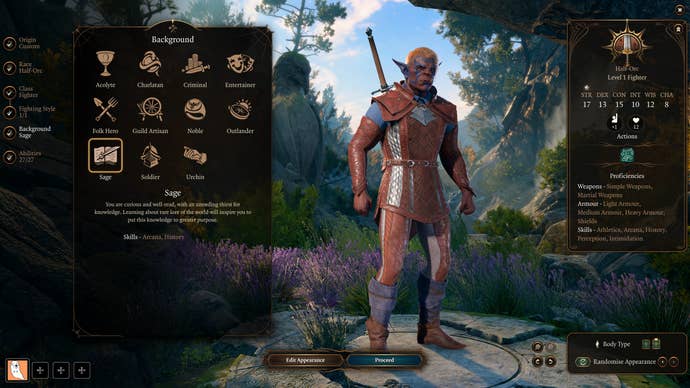
- Pros: Strong and dependable, easy to understand but still with lots of abilities
- Cons: Not great at range, can struggle to hit highly protected enemies
The Battle Master is a skilled, well-rounded warrior who can hold their own in just about any situation. They’re great for beginners because they’re easy to understand while also being powerful enough to not make you feel like you’re missing out on anything.
They’ve got a good health pool, good attacks, and access to a slew of useful weapons and abilities including a self heal and an Action Surge that basically lets you take another turn.
If you’re finding yourself overwhelmed by enemies who seem to be able to do loads more actions than you, look no further. At level 5 the Fighter can perform an extra attack action in their turn. Combined with their Action Surge ability, this means you can do a whopping four attacks in a single turn.
The Githyanki soldier, Lae’zel, who’s one of the main companions in Baldur’s Gate 3 is also a Fighter. However, because of their adaptability, versatility and basic prowess, you won’t feel like your team is unbalanced using two of the same archetype. What’s more they also have access to self healing, which lessens the burden on a support character somewhat.
Thief Rogue
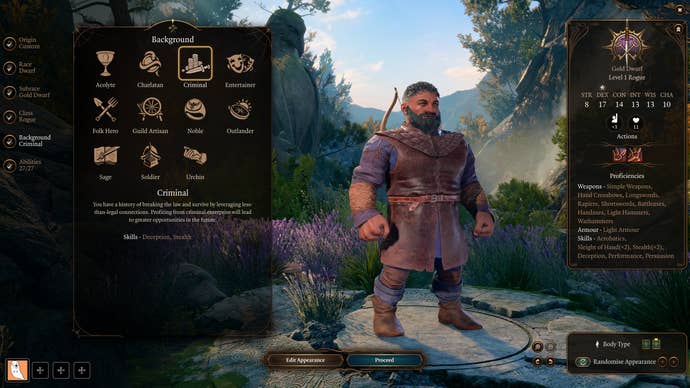
- Pros: High damage, can take lots of actions in a turn
- Cons: Needs to be paired with other characters to draw aggro
Low-key one of the biggest powerhouses in Baldur’s Gate 3, the Thief subclass of the Rogue class is great for beginners because it deals a lot of damage, has a surprisingly good health pool, and lets you perform advanced actions basically for free.
Rogue characters gain access to a “Cunning Action”. This basically allows them to Dash (double their movement total), Hide (secrete themselves stealthily to avoid detection) or Disengage (walk away from an enemy without getting hit by an attack of opportunity) as an extra bonus action. They can then use these actions to gain an advantage when they sneak attack an enemy for huge damage.
Thief Rogues specifically get access to another bonus action early on in their adventure, giving them access to a huge range of movement, a chance at hiding and a very powerful attack almost every turn.
This class is likely how many players will also build Astarion, another of the main companions in Baldur’s Gate 3. But again, combined with a tank and more supportive, healing character your party won’t feel lopsided.
Bear Druid
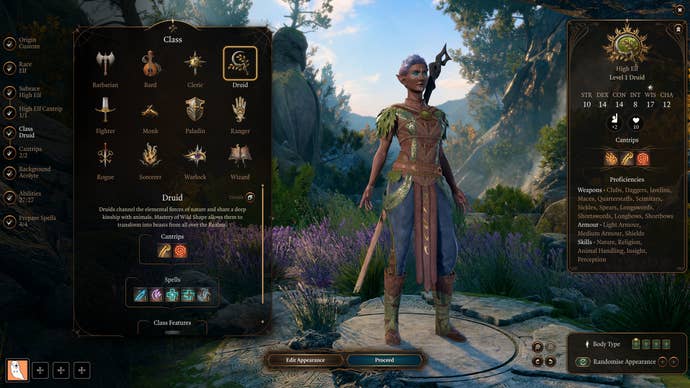
- Pros: Unmatched health pool, you are a bear
- Cons: Can feel like you don’t get many actions in the very early game
A shape-shifting Druid is a fun, flexible and tanky class that’s really easy to understand and enjoy.
Basically: you turn into a giant bear and hit people with your big meaty claws.
There’s a bit more nuance if you want it though. In the early game the Bear form has a huge amount of health and when your shapeshifted health hits zero, you’re just knocked out of the bear form, you’re not dead.
This means you can just jump back into Bear form and tank a load more damage without dying again. Baldur’s Gate 3 is not an easy game, so if you’re finding yourself getting bopped in one hit by tough foes, try a tankier class.
As you level up as a Druid, you start to get access to a lot of powerful spells too. Things like Moonglow and Call: Lightning allow you to reliably throw down damage with a high percentage to hit from almost anywhere on the battlefield, which is invaluable for finishing off foes and punishing those who bunch together.
It’s also worth mentioning that NPC Druids feature heavily in Act 1, so you get a lot of unique dialogue options from being a Druid yourself. Plus, you can also prepare the ability to talk to animals, which gives you loads of funny encounters.
Role-playing Warlock

- Pros: A great variety of spooky spells, more robust than wizards
- Cons: Just because you recharge on a short rest doesn’t mean the rest of your party does
Some of the Warlock class’s main offensive abilities have additional scaling from Charisma. And do you know what else needs a lot of Charisma? Dialogue Checks throughout Baldur’s Gate 3’s story!
Adventuring as a silver-tongued protagonist is a popular play style in Dungeons and Dragons and RPGs in general. This makes the Warlock a natural fit if you want to rely on your created character both in combat and story situations.
The Warlock class is good in and of itself too. They not only have powerful spells that can knock enemies around the battlefield, but can also recover their spell-casting charges during a short rest. Most other spellcaster classes require a long rest to do the same, meaning you can adventure for longer without making as many compromises to conserve energy.
Tanky Paladin

- Pros: Access to healing spells, buffs and strong attacks
- Cons: You have to be a goody two-shoes, don’t you?
Similar to the Warlock, Paladins also use Charisma to aid their spellcasting. However, they’re more focused on hitting monsters with a big hammer than throwing fire bolts.
Paladins have access to a wide range of abilities, including healing and unique buffs, which makes them feel like a busy, capable class.
It also must be said that their basic set looks pretty cool.
How to choose the best class for solo play in Baldur's Gate 3
The thing about playing BG3 solo is that you're not playing it with just one character — you'll still have a party of up to three others by your side, depending on which origin companions (and eventual others) you recruit.
Therefore, if you're looking to build your own character for solo play, you're really talking about building a whole party. And with that in mind, there's something to be said for avoiding the following classes, since you'll be able to switch to them pretty freely after the prologue anyway:
- Cleric (Shadowheart)
- Fighter (Lae'zel)
- Rogue (Astarion)
- Wizard (Gale)
- Warlock (Wyll)
- Barbarian (Karlach)
Later on in the game you'll also have the chance to recruit two Druids (Halsin and Jaehira), a Paladin (Minthara), and a Ranger (Minsc). With the exception of Halsin and Minthara, who are mutually exclusive, you can fill out your solo play party with any three of these at a time.
Looked at from a purely numbers point of view, that means that the best class to pick for solo play is surely the Bard, Monk, or Sorcerer, since these are the only classes you don't have the opportunity to recruit later on.
However, there are a bunch of caveats to this attitude: you might end up not liking one of the companion characters, or missing the chance to recruit them. But if you're like me and you very quickly realised (for example) that you really wanted Astarion, Karlach, and Gale to make up your main crew, it makes sense to pick a class that complements the companions you'd like to have with you along the way.
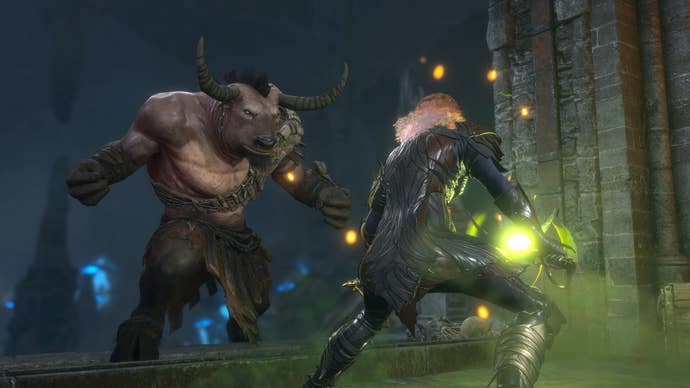
Best class for solo play: support
There's no dedicated healer class in BG3 and most of your healing will probably happen after combat, but getting caught with no healing-capable character on the team is a pain nevertheless. If you've picked your three favourite companions and none of them are Shadowheart, then chances are you'll want to build your character for solo play around their support capacities, with healing being a crucial component. And we reckon that the best class to pick for a solo playthrough if you want your character to provide back-up to their party is the Bard.
Not only will playing as the Bard give you something to do with all the musical instruments you've looted other than carry them around until you find someone to barter them away to, but the Bard can provide essential boosts to healing during combat. But where the Bard really shines is in crowd control, debuffing and sometimes just restraining enemies from attacking until the rest of the party get around to dealing with them, effectively reducing your need for a healer in the first place.
Best class for solo play: all-rounder
Our top choice of class to pick for a solid all-rounder in solo play is the Paladin. For one thing, there's a good chance that you locked yourself out of Minthara's companionship by siding with Halsin against her, meaning there's another class going unrepresented on your roster for starters. No need to tell me if you truly thought Halsin was in the right or you just wanted to smooch him in his bear form; both reasons are entirely valid.
Another good reason is that the Paladin is pretty fantastic as an all-rounder, capable of switching between tanking, DPS, healing, shielding, debuff support, and just about any other job you could care to give them without needing a hugely specific build in each case. To be honest with you, a well-built Paladin wouldn't really need a crew if it weren't for the fact that enemy groups tend to be way too large for a single character to take on alone; they'd be more than capable of taking on the whole game alone if only they had the resources and stamina to do so.
Best class for solo play: DPS
If you want to play a DPS-focused build in BG3 for solo play, you're going to want to multiclass. The D&D 5th Edition that Baldur's Gate 3 takes its systems from basically doesn't want you to have a DPS build, since it's designed around team play, so to circumvent this entirely deliberate feature it makes sense to combine the abilities of a couple of different classes.
There's some freedom to experiment with exact combinations, but many of the best DPS builds favour the Warlock, since they get unparalleled access to Eldritch Blast and are one of the strongest damage-dealing classes in the early game. When choosing a secondary class with an eye to late-game abilities, a more physically-focussed class like Rogue or Ranger is a popular option.
How to choose the best class for multiplayer in Baldur's Gate 3
Perhaps it's a fluffy answer, but the truth is that all of the classes in Baldur's Gate 3 have some outstanding features unique to them; that's why our tier list up top only goes down to "B". So picking a class to play as in a multiplayer campaign with your friends is not actually much different from choosing the best class for solo play: prioritise a build that complements the strengths and weaknesses of the rest of the party, but don't pick a class you aren't actually interested in playing as, and you'll be just fine.
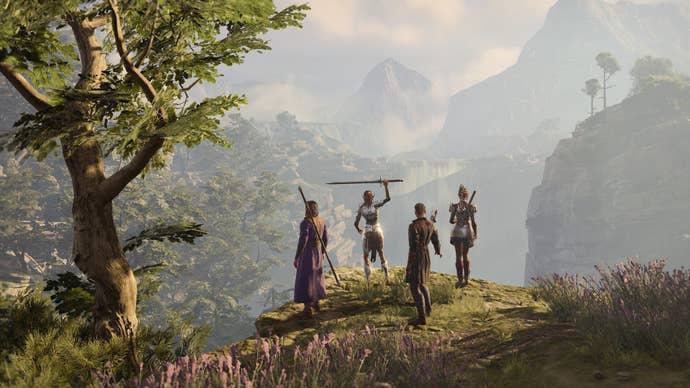
Far more important than your choice of class in multiplayer is having a good strong build. To that end, we've put together recommended build pages for each one of the dozen classes open to you in Baldur's Gate 3. See our comprehensive Baldur's Gate 3 walkthrough for the full list (plus many, many more guides), or take a look at our best Baldur's Gate 3 Bard build and best Baldur's Gate 3 Paladin build pages to get you started with our SS-Tier picks.
